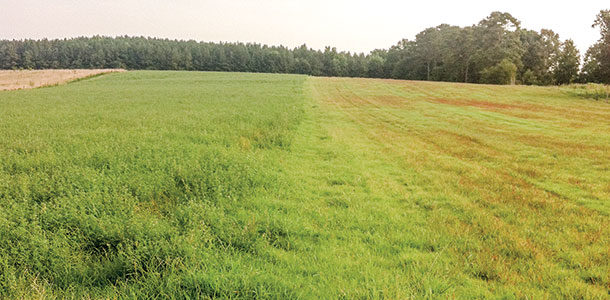3. It makes excellent supplemental feed or cash hay crop.
4. Growing with bermudagrass allows alfalfa to dry faster and be harvested clean.
5. If all else fails, you still have bermudagrass.
Keys to successfully establishing alfalfa into bermudagrass
1. Select a well-drained site for planting.
2. Soil test the site and lime and fertilize according to the recommendations.
- Ideal levels are: pH 6.5, high P and high K; pH at 1-foot depth should be greater than 5.5.
- Pay attention to micronutrient fertilization needs (B and Mo, as needed).
3. Plant at the right time of the year:
- Mountains and Piedmont area, Sept. 15 to Oct. 15
- Coastal Plains region, Oct. 15 to Nov. 15
4. Have bermudagrass very short (1 to 2 inches) whenever planting.
- Spray with a non-selective herbicide:
paraquat (Gramoxone) at 1 quart per acre
glyphosate (Roundup) at 9 oz. per acre if 5.5-pound active ingredient formulation or at 12 oz. per acre if 4-pound active ingredient formulation.
- It is OK to burn off with fire after the chemical burndown.
5. Plant with a no-till drill
- Seeding rate = 22 to 25 pounds per acre
- 7- to 9-inch rows
- Plant no deeper than ½ inch
6. After emergence, spray with insecticide to control mole crickets and other insect pests (Mustang or Karate at the highest labeled rate).
7. Irrigate if available and necessary.
Keys to maintaining alfalfa in bermudagrass
1. Apply K fertility as recommended.
2. Follow K fertility recommendations.
3. Fertilize with K as recommended.
4. Apply B and Mo as recommended.
5. Take a tissue sample one week prior to the second cutting of each year to determine other fertility needs.
6. Scout and spray for alfalfa weevils in February or March and fall armyworms in summer. FG
PHOTO: One of the oldest on-farm demo sites in the UGA program (8 years old) demonstrates the yield and quality of the interseeded alfalfa strip on the left versus the bermudagrass-only stand on the right. Photo courtesy of Joe Bouton.
Click here to read more about alfalfa for bermudagrass management.










